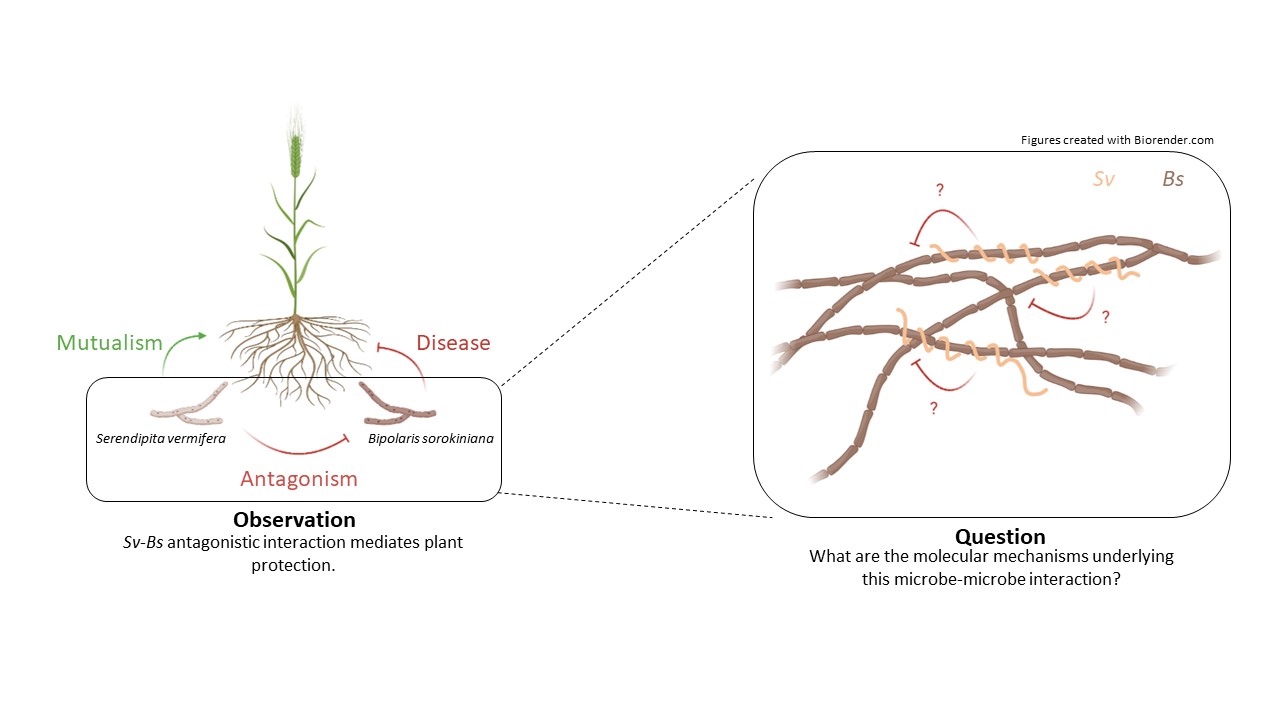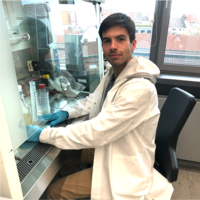How interactions between fungi can condition the physiology of a host plant
A central component of every life history, be it that of humans, a sunflower or a fungus, is the confrontation with external influences from the environment. An organism must always be able to respond appropriately to changes in its immediate environment in order to survive and reproduce. Therefore, every life history is also a history of interactions. In this context, an organism's environment can be categorized into inanimate (abiotic) and animate (biotic) factors. Abiotic factors are physical parameters (e.g., temperature, light conditions, radiation exposure, etc.) while biotic factors represent other organisms or their metabolic products. Interactions with biotic factors occur in diverse forms and between diverse groups of organisms. A simple example is the relationship between a predator and its prey, with each organism representing a biotic factor to the other.
Plants are also exposed to a variety of biotic environmental factors to which they must respond and with which they interact. The root region, in particular, represents a surface of many and diverse interactions with organism living in the soil. This mainly includes microorganisms such as bacteria or fungi that grow in the nutrient-rich region around the root. Some microorganisms can penetrate the root and thus form close interactions that can have positive or negative effects on the health of the plant. Parasitic interactions only confer benefits to one of the interacting partners while harming the other. A fungus that attacks the root of the plant, kills the tissue, and feeds by ingesting the dead material is behaving parasitically. An example of such a fungus is the ascomycete Bipolaris sorokiniana.
Mutualistic interactions (a form of symbiosis), on the other hand, have a positive effect on both interaction partners, under certain environmental conditions. This occurs, for example, through mutual exchange of nutrients. Examples of fungi that can form mutualistic interactions with plants via their roots are the closely related species Serendipita indica and Serendipita vermifera. In addition to some direct beneficial effects on the host plant, such as promoting plant growth, these fungi are additionally able to repel other microbial pathogens such as B. sorokiniana, thus shielding the plant from its harmful effects.
According to current knowledge, direct interactions between the mutualistic species and the parasitic species represent the main part of this protective effect. Simply put, the fungi that are beneficial to the plant directly oppose the harmful invader, suppressing its growth and thus preventing infestation of the plant. Since the protection of the plant is mediated by the direct interaction between the fungi, this is also referred to as microbe-microbe interactions.
While the effect of the interaction between S. vermifera and B. sorokiniana on the health of a host plant (e.g. the model species Arabidopsis thaliana or the crop barley) has already been described, the finding that the closely related species S. indica also has a comparable effect on the pathogen is new. The molecular mechanisms of this interaction, i.e., the processes that occur between the organisms at the molecular level that mediate plant protection, are unknown for both mutualistic species and are the subject of my scientific work. To understand these processes, one must go to the molecular level itself and identify potentially important molecular players and then verify or falsify their role in the interaction between the organisms in experiments.
To gain an overview of potential molecular players in this interaction, it helps to look at the genome of the respective microorganisms and how their genetic repertoire is regulated during the interaction of the two fungi with each other. Genes that stand out here are potentially involved in the interaction and can be studied in the laboratory for their functionality and the biochemical activity of the proteins they encode. Of the candidate genes I identified in the interaction of the mutualistic fungi with the pathogen, some encode potential toxins and cell wall-degrading enzymes. These can be secreted by S. vermifera or S. indica and suppress the growth of B. sorokiniana, thereby protecting the host plant from infestation by the parasite.
Based on the analysis of individual genes and proteins, I am further trying to understand how the activation of these genes is regulated, i.e., whether they are activated together as a network, or finely tuned and independent of each other during the fungi's interaction with each other.

The insights we gain from this research can reveal how direct interactions between organisms have a relevant impact on the physiology of a third organism, such as A. thaliana or barley, and what genetic requirements must be met for such interactions between microorganisms. This is not only of academic interest but potentially relevant for agricultural practice in the future; because understanding which microorganisms and which of their genetic components are able to restrict pathogen infection of plants can contribute to the planning of sustainable agriculture.
Planter's Punch
Under the heading Planter’s Punch we present each month one special aspect of the CEPLAS research programme. All contributions are prepared by our young researchers.
About the author

Ruben Eichfeld is a PhD student at the University of Cologne in the group of Prof. Alga Zuccaro. The group works on the interactions between plants and diverse microorganisms like the endophytic fungi Serendipita indica and Serendipita vermifera. Furthermore, the pathogenic fungus Bipolaris sorokiniana is a model organism in this group. Plant immune reactions as a response to microbial colonization as well as genetic determinants of plant-microbe interactions from the plants and the microbial perspective are investigated in this group. Ruben mainly works on the molecular aspects of fungus-fungus interactions and how these in turn affect plant performance.
Further reading
Sebacinales in microbe-microbe interactions:
Sarkar, D., Rovenich, H., Jeena, G., Nizam, S., Tissier, A., Balcke, G.U., Mahdi, L.K., Bonkowski, M., Langen, G. and Zuccaro, A. (2019), The inconspicuous gatekeeper: endophytic Serendipita vermifera acts as extended plant protection barrier in the rhizosphere. New Phytol, 224: 886-901. https://doi.org/10.1111/nph.15904
Mahdi, L.K., Miyauchi, S., Uhlmann, C. et al. The fungal root endophyte Serendipita vermifera displays inter-kingdom synergistic beneficial effects with the microbiota in Arabidopsis thaliana and barley. ISME J 16, 876–889 (2022). https://doi.org/10.1038/s41396-021-01138-y
About Sebacinales:
Weiß, M., Waller, F., Zuccaro, A. and Selosse, M.-A. (2016), Sebacinales – one thousand and one interactions with land plants. New Phytol, 211: 20-40. https://doi.org/10.1111/nph.13977
About effectormolecules in microbe-microbe interactions:
Nick C Snelders, Hanna Rovenich, Bart P H J Thomma, Microbiota manipulation through the secretion of effector proteins is fundamental to the wealth of lifestyles in the fungal kingdom, FEMS Microbiology Reviews, Volume 46, Issue 5, September 2022, fuac022, https://doi.org/10.1093/femsre/fuac022